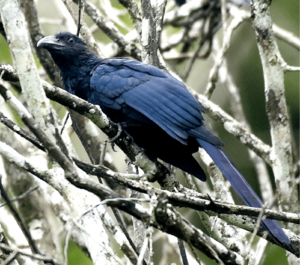Greater ani facts for kids
Quick facts for kids Greater ani |
|
|---|---|
 |
|
| Conservation status | |
| Scientific classification | |
| Genus: |
Crotophaga
|
| Species: |
major
|
 |
|
The greater ani (Crotophaga major) is a cool bird from the cuckoo family. Some people also call it the black cuckoo. You can find these birds in tropical parts of South America, all the way down to northern Argentina.
Contents
About the Greater Ani's Name
The greater ani got its scientific name, Crotophaga major, from a German scientist named Johann Friedrich Gmelin in 1788. He was working on a big book about nature called Systema Naturae.
The first part of its scientific name, Crotophaga, comes from ancient Greek words. Krotōn means "tick" and -phagos means "-eating." So, its name basically means "tick-eating." This gives you a clue about what these birds like to eat!
What Does the Greater Ani Look Like?
The greater ani is about 46 centimeters (about 18 inches) long. That's roughly the length of your forearm!
- Males usually weigh around 162 grams (about 5.7 ounces).
- Females are a bit lighter, weighing about 145 grams (about 5.1 ounces).
Adult greater anis are mostly shiny black with a blue tint. They have a long tail and a big, strong black beak that looks a bit ridged. One cool thing about them is their eyes: adults have bright white eyes! Young birds, however, have brown eyes.
When they talk to each other, their calls sound like croaking or even like a turkey gobbling. They make sounds like kro-koro.
Where Do Greater Anis Live?
You can find the greater ani breeding from Panama and Trinidad all the way through tropical South America down to northern Argentina.
They like to live in places near water, like:
Sometimes, they move from one area to another depending on the season. This means they are seasonal migrants in some parts of their home range.
Greater Ani Behavior and Habits
Greater anis are very social birds. They almost always hang out in noisy groups, so you'll rarely see one by itself!
What Do Greater Anis Eat?
These birds are not picky eaters! They love to munch on large insects like:
They also eat other things like:
Reproduction and Family Life
Greater anis have a unique way of raising their young. They build a nest together, and several pairs of birds will live in it at the same time!
- Their nest is a deep cup shape, lined with leaves.
- They usually build it 2 to 5 meters (about 6 to 16 feet) high in a tree.
Many females will lay their chalky deep blue eggs in the same nest. Then, all the adults in the group share the job of sitting on the eggs to keep them warm (this is called incubation) and feeding the baby birds. Sometimes, other birds who aren't breeding also help out.
Nests have been found with anywhere from 3 to 10 eggs. The eggs hatch in about 11 to 12 days. The baby birds can leave the nest after only five days, but they will still be fed by the adults for several weeks if they choose to stay nearby.
Sometimes, a female ani might lay her eggs in another group's nest, especially if she lost her own eggs to predators. The nesting group might reject some of these extra eggs, especially if the group is very large. Scientists think there's a balance: having more anis helps protect the nest from predators, but too many can lead to competition for food. This is why most nests have about two or three breeding pairs, and more than that is rare.



